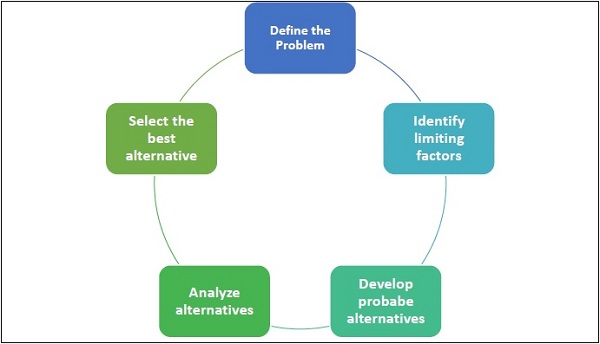decision Making process
The decision-making process involves the following steps −
- Define the problem
- Identify limiting factors
- Develop potential alternatives
- Analyze and select the best alternatives
- Implement the decision

Define the Problem
The first step in the process of decision making is the recognition or identification of the problem, and recognizing that a decision needs to be taken.
It is important to accurately define the problem. Managers can do this by identifying the problem separately from its symptoms. Studying the symptoms helps getting closer to the root cause of the problem.
Identify Limiting Factors
In order to choose the best alternative and make a decision every manager needs to have the ideal resources − information, time, personnel, equipment, and supplies. But this is an ideal situation and may not always be possible.
A limiting factor is something that stands in the way of accomplishing a desired objective.
Develop Potential Alternatives
Recognizing the limiting factor in a given situation makes it possible to narrow down the search for alternatives and make the best decision possible with the information, resources, and time available.
Some methods for developing alternatives are −
Brainstorming, where a group works together to generate ideas and alternative solutions.
Nominal group technique is a method that involves the use of a highly structured meeting, complete with an agenda, and restricts discussion or interpersonal communication during the decision-making process.
Delphi technique where the participants do not meet, but a group leader uses written questionnaires to conduct the decision making.
Analyze the Alternatives
This is an important stage in the decision-making process and perhaps the toughest. Managers must identify the merits and demerits of each alternative and weigh them in light of various situations before making a final decision.
Evaluating the alternatives can be done in numerous ways. Here are a few possibilities −
- Qualitative and quantitative measurements
- Perform a cost‐effectiveness analysis for each alternative
- Marginal analysis
Selecting Alternatives
Once the alternatives are analyzed and evaluated, the manager has to choose the best one. The manager needs to choose the alternative that gives the most advantage while meeting all the required criteria. Sometimes the choice is simple with obvious benefits, at times the optimal solution is a combination of several alternatives. At times when the best alternative may not be obvious, the manager uses probability estimates, research and analysis aided by his experience and judgment.
Evaluating Decision Effectiveness
The job of the managers does not end with making decisions. They are also responsible to get favorable results from the decision taken and implemented.
The effectiveness of a decision can be understood through a systematic and scientific evaluation system that provides feedback on how well the decision is being implemented, what the results have been, and what amendments and adjustments have been made to get the intended results.

Comments
Post a Comment